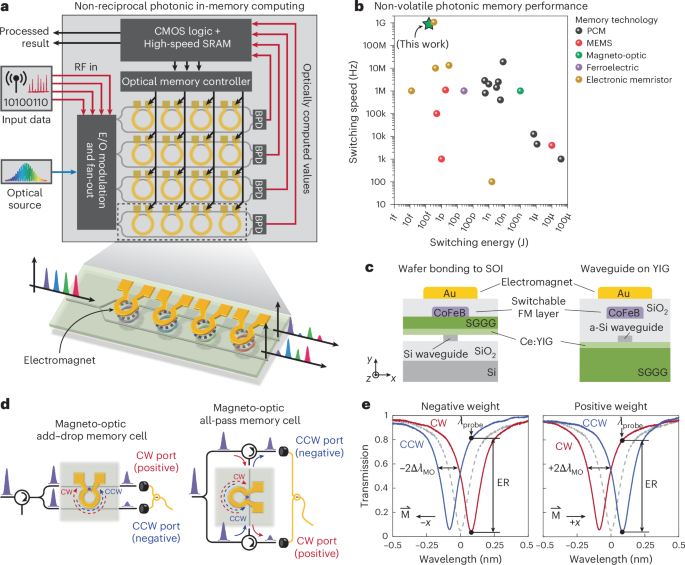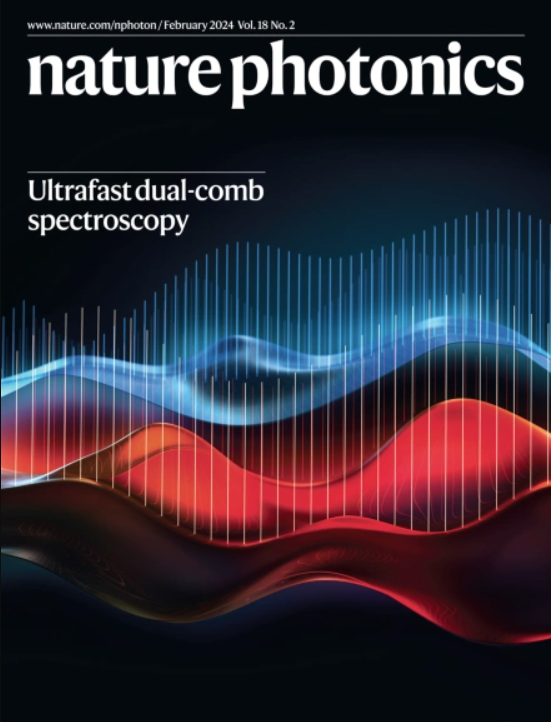用于光子内存计算的具有超高耐用性的集成非互易磁光学器件
IF 32.3
1区 物理与天体物理
Q1 OPTICS
引用次数: 0
摘要
对于人工智能和机器学习领域的各种新兴应用而言,与现有数字硬件相比,光域信息处理在速度和能效方面都具有优势。光子处理的典型方法是将快速变化的光输入向量与固定光权重矩阵相乘。然而,使用光子存储单元阵列在芯片上对这些权重进行编码,目前受到材料和设备层面的各种问题的限制,如编程速度、消光比和耐用性等。在这里,我们提出了一种为内存光子计算进行光权重编码的新方法,即在硅微环谐振器上使用由异质集成的铈取代钇铁石榴石(Ce:YIG)组成的磁光存储单元。我们的研究表明,与现有架构相比,利用这种磁光材料的非互易相移提供了几个关键优势,为片上光学处理提供了一个快速(1 ns)、高效(每比特 143 fJ)和稳健(24 亿编程周期)的平台。本文章由计算机程序翻译,如有差异,请以英文原文为准。


Integrated non-reciprocal magneto-optics with ultra-high endurance for photonic in-memory computing
Processing information in the optical domain promises advantages in both speed and energy efficiency over existing digital hardware for a variety of emerging applications in artificial intelligence and machine learning. A typical approach to photonic processing is to multiply a rapidly changing optical input vector with a matrix of fixed optical weights. However, encoding these weights on-chip using an array of photonic memory cells is currently limited by a wide range of material- and device-level issues, such as the programming speed, extinction ratio and endurance, among others. Here we propose a new approach to encoding optical weights for in-memory photonic computing using magneto-optic memory cells comprising heterogeneously integrated cerium-substituted yttrium iron garnet (Ce:YIG) on silicon micro-ring resonators. We show that leveraging the non-reciprocal phase shift in such magneto-optic materials offers several key advantages over existing architectures, providing a fast (1 ns), efficient (143 fJ per bit) and robust (2.4 billion programming cycles) platform for on-chip optical processing. Researchers demonstrate optical weights for in-memory photonic computing using magneto-optic memory cells comprising Ce:YIG on silicon micro-ring resonators. Non-reciprocal phase shift provides a fast, efficient and robust integrated optical processing platform.
求助全文
通过发布文献求助,成功后即可免费获取论文全文。
去求助
来源期刊

Nature Photonics
物理-光学
CiteScore
54.20
自引率
1.70%
发文量
158
审稿时长
12 months
期刊介绍:
Nature Photonics is a monthly journal dedicated to the scientific study and application of light, known as Photonics. It publishes top-quality, peer-reviewed research across all areas of light generation, manipulation, and detection.
The journal encompasses research into the fundamental properties of light and its interactions with matter, as well as the latest developments in optoelectronic devices and emerging photonics applications. Topics covered include lasers, LEDs, imaging, detectors, optoelectronic devices, quantum optics, biophotonics, optical data storage, spectroscopy, fiber optics, solar energy, displays, terahertz technology, nonlinear optics, plasmonics, nanophotonics, and X-rays.
In addition to research papers and review articles summarizing scientific findings in optoelectronics, Nature Photonics also features News and Views pieces and research highlights. It uniquely includes articles on the business aspects of the industry, such as technology commercialization and market analysis, offering a comprehensive perspective on the field.
 求助内容:
求助内容: 应助结果提醒方式:
应助结果提醒方式:


